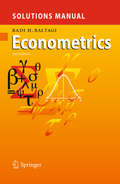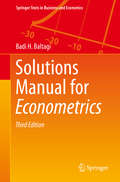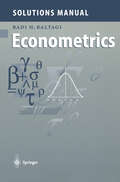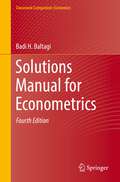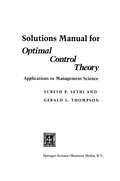- Table View
- List View
Solution Techniques for Elementary Partial Differential Equations
by Christian ConstandaSolution Techniques for Elementary Partial Differential Equations, Third Edition remains a top choice for a standard, undergraduate-level course on partial differential equations (PDEs). Making the text even more user-friendly, this third edition covers important and widely used methods for solving PDEs. New to the Third Edition New sections on the series expansion of more general functions, other problems of general second-order linear equations, vibrating string with other types of boundary conditions, and equilibrium temperature in an infinite strip Reorganized sections that make it easier for students and professors to navigate the contents Rearranged exercises that are now at the end of each section/subsection instead of at the end of the chapter New and improved exercises and worked examples A brief Mathematica® program for nearly all of the worked examples, showing students how to verify results by computer This bestselling, highly praised textbook uses a streamlined, direct approach to develop students’ competence in solving PDEs. It offers concise, easily understood explanations and worked examples that allow students to see the techniques in action.
Solution Techniques for Elementary Partial Differential Equations
by Christian ConstandaSolution Techniques for Elementary Partial Differential Equations, Third Edition remains a top choice for a standard, undergraduate-level course on partial differential equations (PDEs). Making the text even more user-friendly, this third edition covers important and widely used methods for solving PDEs. New to the Third Edition New sections on the series expansion of more general functions, other problems of general second-order linear equations, vibrating string with other types of boundary conditions, and equilibrium temperature in an infinite strip Reorganized sections that make it easier for students and professors to navigate the contents Rearranged exercises that are now at the end of each section/subsection instead of at the end of the chapter New and improved exercises and worked examples A brief Mathematica® program for nearly all of the worked examples, showing students how to verify results by computer This bestselling, highly praised textbook uses a streamlined, direct approach to develop students’ competence in solving PDEs. It offers concise, easily understood explanations and worked examples that allow students to see the techniques in action.
Solution Techniques for Elementary Partial Differential Equations
by Christian Constanda"In my opinion, this is quite simply the best book of its kind that I have seen thus far."—Professor Peter Schiavone, University of Alberta, from the Foreword to the Fourth Edition Praise for the previous editions An ideal tool for students taking a first course in PDEs, as well as for the lecturers who teach such courses."—Marian Aron, Plymouth University, UK "This is one of the best books on elementary PDEs this reviewer has read so far. Highly recommended."—CHOICE Solution Techniques for Elementary Partial Differential Equations, Fourth Edition remains a top choice for a standard, undergraduate-level course on partial differential equations (PDEs). It provides a streamlined, direct approach to developing students’ competence in solving PDEs, and offers concise, easily understood explanations and worked examples that enable students to see the techniques in action. New to the Fourth Edition Two additional sections A larger number and variety of worked examples and exercises A companion pdf file containing more detailed worked examples to supplement those in the book, which can be used in the classroom and as an aid to online teaching
Solution Techniques for Elementary Partial Differential Equations
by Christian Constanda"In my opinion, this is quite simply the best book of its kind that I have seen thus far."—Professor Peter Schiavone, University of Alberta, from the Foreword to the Fourth Edition Praise for the previous editions An ideal tool for students taking a first course in PDEs, as well as for the lecturers who teach such courses."—Marian Aron, Plymouth University, UK "This is one of the best books on elementary PDEs this reviewer has read so far. Highly recommended."—CHOICE Solution Techniques for Elementary Partial Differential Equations, Fourth Edition remains a top choice for a standard, undergraduate-level course on partial differential equations (PDEs). It provides a streamlined, direct approach to developing students’ competence in solving PDEs, and offers concise, easily understood explanations and worked examples that enable students to see the techniques in action. New to the Fourth Edition Two additional sections A larger number and variety of worked examples and exercises A companion pdf file containing more detailed worked examples to supplement those in the book, which can be used in the classroom and as an aid to online teaching
Solutions Manual and Computer Programs for Physical and Computational Aspects of Convective Heat Transfer
by Tuncer Cebeci P. BradshawThis book is designed to accompany Physical and Computational Aspects of Convective Heat Transfer by T. Cebeci and P. Bradshaw and contains solutions to the exercises and computer programs for the numerical methods contained in that book. Physical and Computational Aspects of Convective Heat Transfer begins with a thorough discussion of the physical aspects of convective heat transfer and presents in some detail the partial differential equations governing the transport of thermal energy in various types of flows. The book is intended for senior undergraduate and graduate students of aeronautical, chemical, civil and mechanical engineering. It can also serve as a reference for the practitioner.
Solutions Manual for Econometrics (Springer Texts in Business and Economics)
by Badi H. BaltagiThis Second Edition updates the Solutions Manual for Econometrics to match the fourth edition of the Econometrics textbook. It corrects typos in the previous edition and adds problems and solutions using latest software versions of Stata and EViews. Special features include empirical examples using EViews and Stata. The book offers rigourous proofs and treatment of difficult econometrics concepts in a simple and clear way, and it provides the reader with both applied and theoretical econometrics problems along with their solutions.
Solutions Manual for Econometrics (Springer Texts in Business and Economics)
by Badi H. BaltagiThis Third Edition updates the "Solutions Manual for Econometrics" to match the Fifth Edition of the Econometrics textbook. It adds problems and solutions using latest software versions of Stata and EViews. Special features include empirical examples using EViews and Stata. The book offers rigorous proofs and treatment of difficult econometrics concepts in a simple and clear way, and it provides the reader with both applied and theoretical econometrics problems along with their solutions.
Solutions Manual for Econometrics
by Badi H. BaltagiThis manual provides solutions to selected exercises from each chapter of Econometrics by Badi H. Baltagi starting with Chapter 2. For the empirical exercises some SAS® programs are provided to replicate the results. Most graphs are plotted using EViews. Some of the problems and solutions are obtained from Econometric Theory (ET) and these are reprinted with the pennission of Cambridge University Press. I would like to thank Peter C. B. Phillips. and the editors of the Problems and Solutions section, Alberto Holly and Juan Dolado for this useful service to the econometrics profession. I would also like to thank my colleague James M Griffin for providing many empirical problems and data sets. I have also used three empirical data sets from Lott and Ray (1992). The reader is encouraged to apply these econometric techniques to their own data sets and to replicate the results of published articles. Some journals/authors provide data sets upon request or are readily available on the web. Other empirical examples are given in Lott and Ray (1992) and Berndt (1991). Finally I would like to thank my students Wei-Wen Xiong, Ming-Jang Weng and Kiseok Nam who solved several of these exercises. Please report any errors, typos or suggestions to: Badi H. Baltagi, Department of Economics, Texas A&M University, College Station, Texas 77843-4228. Telephone (409) 845-7380, Fax (409) 847-8757, or send EMAIL toBadi@econ. tamu. edu. Table of Contents Preface . . . . . . . . . . . . . . . . . . . . . . . . . . . . . . . . . . . . . . . . . . . . . . . . . . . . . . . . . V Chapter 2 A Review of Some Basic Statistical Concepts Chapter 3 Simple Linear Regression . . . . . . . . . . . . . . . . . . . . . . . . . . . . . . . . . . . . . . . . . . .
Solutions Manual for Econometrics (Classroom Companion: Economics)
by Badi H. BaltagiThis Fourth Edition updates the "Solutions Manual for Econometrics" to match the Sixth Edition of the Econometrics textbook. It adds problems and solutions using latest software versions of Stata and EViews. Special features include empirical examples replicated using EViews, Stata as well as SAS. The book offers rigorous proofs and treatment of difficult econometrics concepts in a simple and clear way, and provides the reader with both applied and theoretical econometrics problems along with their solutions. These should prove useful to students and instructors using this book.
Solutions Manual for Geometry: A High School Course
by Philip CarlsonThis book presents the worked-out solutions for all the exercises in the text by Lang and Murrow. It will be of use not only to mathematics teachers, but also to students using the text for self-study.
Solutions Manual for Lang’s Linear Algebra
by Rami ShakarchiThis solutions manual for Lang’s Undergraduate Analysis provides worked-out solutions for all problems in the text. They include enough detail so that a student can fill in the intervening details between any pair of steps.
Solutions Manual for Optimal Control Theory: Applications to Management Science
by Suresh P. Sethi Gerald L. ThompsonSolutions Manual to Accompany Beginning Partial Differential Equations (Pure and Applied Mathematics: A Wiley Series of Texts, Monographs and Tracts)
by Peter V. O'NeilSolutions Manual to Accompany Beginning Partial Differential Equations, 3rd Edition Featuring a challenging, yet accessible, introduction to partial differential equations, Beginning Partial Differential Equations provides a solid introduction to partial differential equations, particularly methods of solution based on characteristics, separation of variables, as well as Fourier series, integrals, and transforms. Thoroughly updated with novel applications, such as Poe's pendulum and Kepler's problem in astronomy, this third edition is updated to include the latest version of Maples, which is integrated throughout the text. New topical coverage includes novel applications, such as Poe's pendulum and Kepler's problem in astronomy.
Solutions Manual to Accompany Beginning Partial Differential Equations (Pure and Applied Mathematics: A Wiley Series of Texts, Monographs and Tracts)
by Peter V. O'NeilSolutions Manual to Accompany Beginning Partial Differential Equations, 3rd Edition Featuring a challenging, yet accessible, introduction to partial differential equations, Beginning Partial Differential Equations provides a solid introduction to partial differential equations, particularly methods of solution based on characteristics, separation of variables, as well as Fourier series, integrals, and transforms. Thoroughly updated with novel applications, such as Poe's pendulum and Kepler's problem in astronomy, this third edition is updated to include the latest version of Maples, which is integrated throughout the text. New topical coverage includes novel applications, such as Poe's pendulum and Kepler's problem in astronomy.
Solutions Manual to Accompany Classical Geometry: Euclidean, Transformational, Inversive, and Projective
by I. E. Leonard J. E. Lewis A. C. Liu G. W. TokarskySolutions Manual to accompany Classical Geometry: Euclidean, Transformational, Inversive, and Projective Written by well-known mathematical problem solvers, Classical Geometry: Euclidean, Transformational, Inversive, and Projective features up-to-date and applicable coverage of the wide spectrum of geometry and aids readers in learning the art of logical reasoning, modeling, and proof. With its reader-friendly approach, this undergraduate text features self-contained topical coverage and provides a large selection of solved exercises to aid in reader comprehension. Material in this text can be tailored for a one-, two-, or three-semester sequence.
Solutions Manual to Accompany Classical Geometry: Euclidean, Transformational, Inversive, and Projective
by I. E. Leonard J. E. Lewis A. C. Liu G. W. TokarskySolutions Manual to accompany Classical Geometry: Euclidean, Transformational, Inversive, and Projective Written by well-known mathematical problem solvers, Classical Geometry: Euclidean, Transformational, Inversive, and Projective features up-to-date and applicable coverage of the wide spectrum of geometry and aids readers in learning the art of logical reasoning, modeling, and proof. With its reader-friendly approach, this undergraduate text features self-contained topical coverage and provides a large selection of solved exercises to aid in reader comprehension. Material in this text can be tailored for a one-, two-, or three-semester sequence.
Solutions Manual to accompany Combinatorial Reasoning: An Introduction To The Art Of Counting
by Duane DeTemple William WebbThis is a solutions manual to accompany Combinatorial Reasoning: An Introduction to the Art of Counting Written by well-known scholars in the field, Combinatorial Reasoning: An Introduction to the Art of Counting introduces combinatorics alongside modern techniques, showcases the interdisciplinary aspects of the topic, and illustrates how to problem solve with a multitude of exercises throughout. The authors' approach is very reader-friendly and avoids the "scholarly tone" found in many books on this topic.
Solutions Manual to accompany Combinatorial Reasoning: An Introduction To The Art Of Counting
by Duane DeTemple William WebbThis is a solutions manual to accompany Combinatorial Reasoning: An Introduction to the Art of Counting Written by well-known scholars in the field, Combinatorial Reasoning: An Introduction to the Art of Counting introduces combinatorics alongside modern techniques, showcases the interdisciplinary aspects of the topic, and illustrates how to problem solve with a multitude of exercises throughout. The authors' approach is very reader-friendly and avoids the "scholarly tone" found in many books on this topic.
Solutions Manual to accompany Finite Mathematics: Models and Applications
by Carla C. Morris Robert M. StarkA solutions manual to accompany Finite Mathematics: Models and Applications In order to emphasize the main concepts of each chapter, Finite Mathematics: Models and Applications features plentiful pedagogical elements throughout such as special exercises, end notes, hints, select solutions, biographies of key mathematicians, boxed key principles, a glossary of important terms and topics, and an overview of use of technology. The book encourages the modeling of linear programs and their solutions and uses common computer software programs such as LINDO. In addition to extensive chapters on probability and statistics, principles and applications of matrices are included as well as topics for enrichment such as the Monte Carlo method, game theory, kinship matrices, and dynamic programming. Supplemented with online instructional support materials, the book features coverage including: Algebra Skills Mathematics of Finance Matrix Algebra Geometric Solutions Simplex Methods Application Models Set and Probability Relationships Random Variables and Probability Distributions Markov Chains Mathematical Statistics Enrichment in Finite Mathematics
Solutions Manual to accompany Finite Mathematics: Models and Applications
by Carla C. Morris Robert M. StarkA solutions manual to accompany Finite Mathematics: Models and Applications In order to emphasize the main concepts of each chapter, Finite Mathematics: Models and Applications features plentiful pedagogical elements throughout such as special exercises, end notes, hints, select solutions, biographies of key mathematicians, boxed key principles, a glossary of important terms and topics, and an overview of use of technology. The book encourages the modeling of linear programs and their solutions and uses common computer software programs such as LINDO. In addition to extensive chapters on probability and statistics, principles and applications of matrices are included as well as topics for enrichment such as the Monte Carlo method, game theory, kinship matrices, and dynamic programming. Supplemented with online instructional support materials, the book features coverage including: Algebra Skills Mathematics of Finance Matrix Algebra Geometric Solutions Simplex Methods Application Models Set and Probability Relationships Random Variables and Probability Distributions Markov Chains Mathematical Statistics Enrichment in Finite Mathematics
Solutions Manual to accompany Fundamentals of Calculus
by Carla C. Morris Robert M. StarkA solutions manual to accompany Fundamentals of Calculus Fundamentals of Calculus illustrates the elements of finite calculus with the varied formulas for power, quotient, and product rules that correlate markedly with traditional calculus. Featuring calculus as the “mathematics of change,” each chapter concludes with a historical notes section. Fundamentals of Calculus chapter coverage includes: Linear Equations and Functions Integral Calculus The Derivative Integrations Techniques Using the Derivative Functions of Several Variables Exponents and Logarithms Series and Summations Differentiation Techniques Applications to Probability
Solutions Manual to accompany Fundamentals of Calculus
by Carla C. Morris Robert M. StarkA solutions manual to accompany Fundamentals of Calculus Fundamentals of Calculus illustrates the elements of finite calculus with the varied formulas for power, quotient, and product rules that correlate markedly with traditional calculus. Featuring calculus as the “mathematics of change,” each chapter concludes with a historical notes section. Fundamentals of Calculus chapter coverage includes: Linear Equations and Functions Integral Calculus The Derivative Integrations Techniques Using the Derivative Functions of Several Variables Exponents and Logarithms Series and Summations Differentiation Techniques Applications to Probability
Solutions Manual to accompany Fundamentals of Matrix Analysis with Applications
by Edward Barry Saff Arthur David SniderSolutions Manual to accompany Fundamentals of Matrix Analysis with Applications—an accessible and clear introduction to linear algebra with a focus on matrices and engineering applications.
Solutions Manual to accompany Fundamentals of Matrix Analysis with Applications
by Edward Barry Saff Arthur David SniderSolutions Manual to accompany Fundamentals of Matrix Analysis with Applications—an accessible and clear introduction to linear algebra with a focus on matrices and engineering applications.
Solutions Manual to Accompany Geometry of Convex Sets
by I. E. Leonard J. E. LewisA Solutions Manual to accompany Geometry of Convex Sets Geometry of Convex Sets begins with basic definitions of the concepts of vector addition and scalar multiplication and then defines the notion of convexity for subsets of n-dimensional space. Many properties of convex sets can be discovered using just the linear structure. However, for more interesting results, it is necessary to introduce the notion of distance in order to discuss open sets, closed sets, bounded sets, and compact sets. The book illustrates the interplay between these linear and topological concepts, which makes the notion of convexity so interesting.Thoroughly class-tested, the book discusses topology and convexity in the context of normed linear spaces, specifically with a norm topology on an n-dimensional space.Geometry of Convex Sets also features: An introduction to n-dimensional geometry including points; lines; vectors; distance; norms; inner products; orthogonality; convexity; hyperplanes; and linear functionals Coverage of n-dimensional norm topology including interior points and open sets; accumulation points and closed sets; boundary points and closed sets; compact subsets of n-dimensional space; completeness of n-dimensional space; sequences; equivalent norms; distance between sets; and support hyperplanes · Basic properties of convex sets; convex hulls; interior and closure of convex sets; closed convex hulls; accessibility lemma; regularity of convex sets; affine hulls; flats or affine subspaces; affine basis theorem; separation theorems; extreme points of convex sets; supporting hyperplanes and extreme points; existence of extreme points; Krein–Milman theorem; polyhedral sets and polytopes; and Birkhoff’s theorem on doubly stochastic matrices Discussions of Helly’s theorem; the Art Gallery theorem; Vincensini’s problem; Hadwiger’s theorems; theorems of Radon and Caratheodory; Kirchberger’s theorem; Helly-type theorems for circles; covering problems; piercing problems; sets of constant width; Reuleaux triangles; Barbier’s theorem; and Borsuk’s problem Geometry of Convex Sets is a useful textbook for upper-undergraduate level courses in geometry of convex sets and is essential for graduate-level courses in convex analysis. An excellent reference for academics and readers interested in learning the various applications of convex geometry, the book is also appropriate for teachers who would like to convey a better understanding and appreciation of the field to students.I. E. Leonard, PhD, was a contract lecturer in the Department of Mathematical and Statistical Sciences at the University of Alberta. The author of over 15 peer-reviewed journal articles, he is a technical editor for the Canadian Applied Mathematical Quarterly journal.J. E. Lewis, PhD, is Professor Emeritus in the Department of Mathematical Sciences at the University of Alberta. He was the recipient of the Faculty of Science Award for Excellence in Teaching in 2004 as well as the PIMS Education Prize in 2002.



